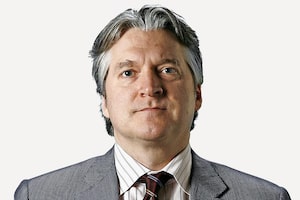
A bike lane at the corner of Gerrard St. E and Greenwood Ave. in Toronto's East End. A bike lane separated by a solid white line like this should only be used by bikes and buses.Andrew Clark/The Globe and Mail
There were two cars in front of me at the red light. We all had our signals blinking waiting to turn right. To our right was a narrow solid-green lane adorned by a bicycle icon and a diamond.
It is a bike lane, according to a Ashika Theyyil with the City of Toronto. “Buses may enter to pick up and drop off passengers at the bus stop. The solid white line indicates that other vehicles should not enter the lane.”
Well, all those indicators clearly didn’t work.
A driver most likely saw clearly the green and the bike icon and the arrow and was very aware “of people cycling” and then shot by, pausing briefly at the red light before using the green lane as his own personal right-turn lane.
When is a bike lane not a bike lane? Anytime a driver wants to use it, apparently.
It happens all the time in many cities. The temptation is too great. In Toronto, a driver was caught by a news helicopter using a bike lane for an extended spree. If you think last year’s Convoy Freedom Protest in Ottawa was bad, imagine if Ottawa had more bike lanes. The government could have ordered the Emergencies Act with a side-order of Notwithstanding Clause and those truckers would still be there grilling sausages and inflating bouncy castles in their bike-lane-occupying big rigs.
The solution is simple – change the name. If drivers are going to use them whenever the spirit moves them, the name should reflect this reality. “Bike lane” is a little harsh and imperative. It doesn’t truly describe the thoroughfare. Here are a few to consider:
Bike Suggestions – Unless a bike lane is walled off by concrete, it’s a bike lane in name only. Anytime a delivery driver wants to park there or a driver in a hurry needs to get somewhere, it’s a “Bike Suggestion.”
Bike? – By adding a question mark, the name conveys the ephemeral nature of bike lanes and reflects the fleeting nature of all existence. Like life, bike lanes are at best mirrors of a future that does not exist. It reminds the driver that yes, this lane was created for bikes not cars, but in a way that acknowledges there is nothing that the passage of time does not demolish and remove. So, if you want to drive in the bike lane go ahead.
Small Car Lane – Do you really need to have the word “Bike” in “Bike Lane?” It smacks of elitism and exclusion. At amusement parks there are signs that say, “You must be this tall to ride.” Apply the same criterion to cars in the bike lane. If your vehicle is small, you can use it.
The Worlds Narrowest and Longest Parking Lot – There are 350 kilometres of bike lanes and paths in Montreal, 290 in Calgary, 450 in Vancouver and 500 in Toronto. If we estimate conservatively, that at any given moment, 10 per cent of these are occupied by vehicles, that means 159 kilometres of bike lanes are being used as ad hoc parking spaces. That’s one long parking lot.
If you want to place more of an emphasis on what cyclists experience using bike lanes, they could be renamed:
- “Hey, look out!”
- Thoughts and Prayers Lanes
- Doors. Doors. Doors.
- “It’s true what they say, your life really does flash before your eyes lanes”
Of course, traffic police could be more forceful in ticketing drivers who use the bike lane. I know law enforcement is stretched, but when you factor the number of injuries and deaths that cyclists suffer, it seems worth it.
Drivers could be more responsible, too. They could acknowledge that they share the road, they don’t own it. That they have an obligation to drive defensively and leave the bike lanes clear for cyclists.
You know, I think there’s already a name for that – Dreaming.
 Andrew Clark
Andrew Clark